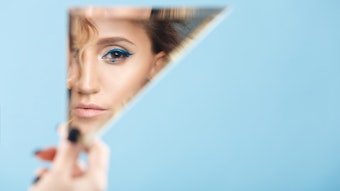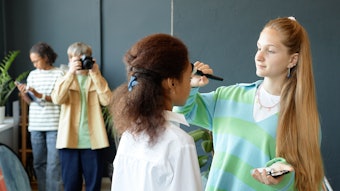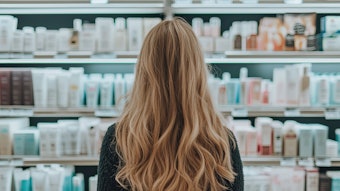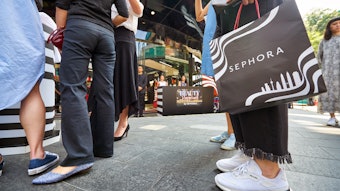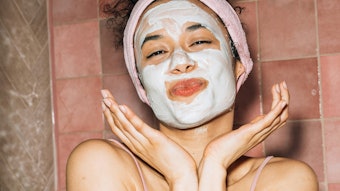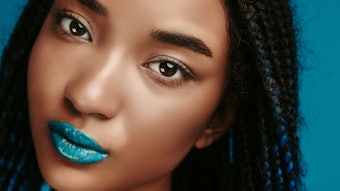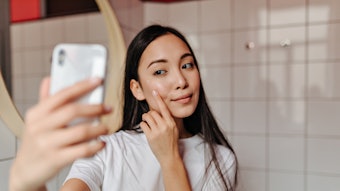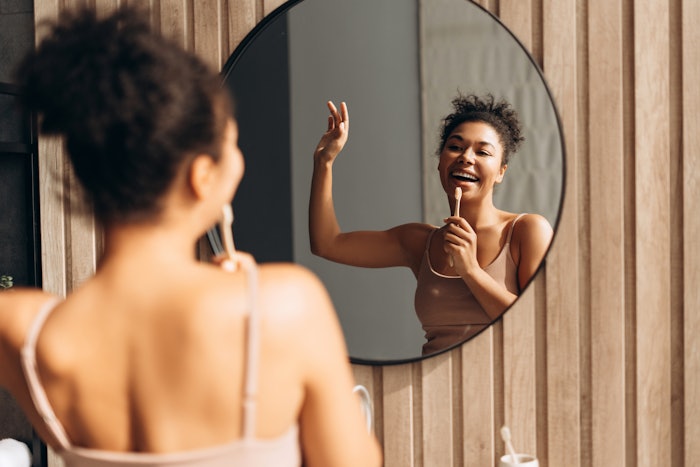
Abstract: The skin doesn’t just reflect your health — it mirrors your mind. Here, expert Hemali Gunt, Ph.D., explains how stress, mood and beauty routines are biologically linked, and why the future of skin care is rooted in emotional and psychological wellness.
Nutricosmetics (beauty supplements): Over the last 20 years, the market for ingestible beauty has increased significantly. Collagen peptides (powders, drinks, gummies), biotin and keratin supplements, multivitamins targeting skin-glow, herbal blends (e.g., ashwagandha for stress-reduction and hair health) and probiotics/prebiotics have become mainstream.
Functional foods and beverages: Closely related, the trend of functional foods overlaps nutrition and beauty. Beauty-boosting juices, teas and even alcoholic beverages (e.g., collagen-infused wines) along with superfoods like matcha, berries and chocolate with added collagen/enzymes blur lines between nutrition and aesthetics.
Spa/wellness devices and services: The wellness-beauty crossover also appears in treatments: facial massages, acupuncture-based facials, cryotherapy, saunas and infrared cabins promise cosmetic and systemic benefits. At-home devices like LED light masks aim to improve mood (blue light for wakefulness, red for skin repair). Sleep masks with guided relaxation, scalp massagers and even beauty apps (tracking diet-skin links) are developing.
This article is only available to registered users.
Log In to View the Full Article
Abstract: The skin doesn’t just reflect your health — it mirrors your mind. Here, expert Hemali Gunt, Ph.D., explains how stress, mood and beauty routines are biologically linked, and why the future of skin care is rooted in emotional and psychological wellness.
The interwoven nature of human emotion, wellness and beauty has never been more evident — and research continually uncovers new and deeper connections. Take the recent Unilever study published in the British Journal of Dermatology, for example.
Samples from the microbiomes of 53 adults taken across four body sites, paired with psychological assessments of stress, mood, sleep quality and well-being, suggested that higher levels of Cutibacterium, a common skin bacterium, could be linked to lower stress and improved mood. According to the researchers, this highlights the potential of the bacterium to act along the skin–brain axis — the path where psychological stress can influence skin health, and vice versa.
But this brain-skin-emotion narrative has been prevalent across our industry for some time now. It rose to the top as a major theme at IFSCC 2018 in Munich. It's been the focus of a dedicated column in Cosmetics & Toiletries (C&T) by Katerina Steventon, Ph.D.; articles by Guzman Alonso and Jiménez; and others.
It also emerged in a previous discussion with R&D scientist Shilpi Jain, founder of the prestige brand Skinveda, who drew parallels between psychodermatology and ayurveda.
"The whole premise behind ayurveda is the balance of the three vital energies (doshas)," she explained. "These are really based on your mind-body constitution and how it is affected by extrinsic and intrinsic stress factors. This is reflected in your skin – so it’s the manifestation of stress in your body’s largest organ."
Continuing the discussion of the wellness and beauty intersection, C&T reached out to Hemali Gunt, Ph.D. (HG), an industry expert and founder of DermaSphere Consulting, for her insights on this space. She shared the following.
C&T: How do wellness and beauty intersect? What aspects can we measure to prove these connections?
HG: Often beauty and wellness are viewed as distinct concepts, but they are not parallel tracks. They are biologically and psychologically intertwined, with growing evidence showing that one actively shapes the other.
While beauty has long been associated with external appearance and wellness with internal balance, emerging research shows that the two domains reinforce each other. For example, a 2024 randomized trial in Brazilian women found that simply applying makeup reduced depressive symptoms and salivary cortisol, a key stress hormone, within hours, highlighting how beauty rituals can yield measurable stress relief and mood elevation.
Beauty routines once seen as purely aesthetic are increasingly recognized as quantifiable wellness interventions, capable of influencing neuroendocrine, immune and psychological health."
Conversely, chronic psychological stress has been shown to disrupt skin homeostasis through the hypothalamic-pituitary-adrenal (HPA) axis and immune-inflammatory pathways, exacerbating conditions like acne, eczema, or hair loss. These visible conditions often lead to further emotional distress, creating a feedback loop of biological and psychological burden.
Modern wellness-beauty science now uses clinical-grade tools to quantify these effects. Biomarkers such as cortisol, IL-6 and TNF-α measure stress and inflammation; validated psychological inventories assess mood, energy, sleep and self-esteem, while imaging and biometric tools (like fMRI or HRV) provide insights into mind-body resilience. Skin-specific markers such as TEWL, pH and redness add further granularity.
In summary, beauty routines once seen as purely aesthetic are increasingly recognized as quantifiable wellness interventions, capable of influencing neuroendocrine, immune and psychological health. As measurement tools evolve from biomarkers to behavioral assessments, we are entering an era where the physiological benefits of self-care can be rigorously studied and validated, inviting deeper scientific inquiry and interdisciplinary collaboration to unlock the therapeutic potential of everyday rituals.
 "Many skin care lines now include wellness claims. Serums have adaptogens for stress defense, or CBD/hemp extracts for anti-inflammatory effects. Aromatherapy and botanical oils are standard in luxury products. Sunscreens emphasize antioxidants and skin barrier repair to protect overall health."Image by peopleimages.com at Adobe Stock
"Many skin care lines now include wellness claims. Serums have adaptogens for stress defense, or CBD/hemp extracts for anti-inflammatory effects. Aromatherapy and botanical oils are standard in luxury products. Sunscreens emphasize antioxidants and skin barrier repair to protect overall health."Image by peopleimages.com at Adobe Stock
C&T: Why has wellness entered the beauty and personal care space? What were the drivers?
HG: Wellness has entered the beauty and personal care space not merely as a trend, but as a structural shift fueled by health-conscious consumers, integrative science and a cultural redefinition of beauty itself.
Today’s consumers, especially Millennials and Gen Z, view beauty through a holistic lens, seeking products that not only enhance appearance but also nourish the body and support mental and emotional health.
Hippocrates taught that diet and lifestyle prevent disease, an idea echoed today in functional beauty. What we are witnessing now is a modern, measurable expression of that wisdom, powered by biology, technology and a collective return to self-integrated care."
In 2024, 82% of Americans and 87% of Chinese consumers reported prioritizing wellness daily. This mindset is reflected in rising spend on appearance, nutrition and mindfulness, as well as the evolving vocabulary of beauty: terms like adaptive, restorative and mindful now appear on product labels.
Several trends have driven this convergence. First, the rise of functional nutrition and clean-label awareness shifted interest toward ingestibles and beauty-from-within solutions, such as collagen powders and herbal adaptogens.
Second, the COVID-19 pandemic and a booming wellness culture made self-care a priority: more than 80% of U.S. consumers now rank wellness as a top priority. Younger generations especially spend more on wellness across categories (sleep aids, nutrition, mindfulness and even beauty).
Third, technology and science fueling personalized health (genetic tests, apps) have inspired a more integrated, science-based approach to beauty. And across social media, influencers have normalized beauty routines that include green juices, meditation and gut health as part of looking radiant.
Thematically, this intersection is not entirely new. Hippocrates taught that diet and lifestyle prevent disease, an idea echoed today in functional beauty. What we are witnessing now is a modern, measurable expression of that wisdom, powered by biology, technology and a collective return to self-integrated care.
C&T: What types of wellness-related products support beauty outcomes? How have these evolved over time?
HG: Wellness-inspired beauty products span a wide spectrum, from ingestibles to topical treatments. Broadly, we can categorize them as: a) ingestible supplements and foods; b) topical cosmeceuticals with wellness actives; and c) services/devices blending spa or tech innovations.
Nutricosmetics (beauty supplements): Over the last 20 years, the market for ingestible beauty has increased significantly. Collagen peptides (powders, drinks, gummies), biotin and keratin supplements, multivitamins targeting skin-glow, herbal blends (e.g., ashwagandha for stress-reduction and hair health) and probiotics/prebiotics have become mainstream.
A 2025 industry report highlights surging demand for beauty supplements containing ginseng, probiotics, hyaluronic acid and collagen. Notably, Asia dominates the nutricosmetics market (~70%), driving innovation that Western markets now replicate. Ingredients once confined to traditional medicine (e.g., turmeric, goji berry, pearl powder) have been re-formulated into capsules and drinks.
Functional foods and beverages: Closely related, the trend of functional foods overlaps nutrition and beauty. Beauty-boosting juices, teas and even alcoholic beverages (e.g., collagen-infused wines) along with superfoods like matcha, berries and chocolate with added collagen/enzymes blur lines between nutrition and aesthetics.
Drinks marketed as collagen waters are common on retail shelves and traditional ingredients like turmeric, goji berry and pearl powder are now repackaged into wellness beverages or beauty shots aimed at promoting radiance and resilience.
Beauty is no longer seen as an isolated aesthetic outcome, but as a systemic reflection of internal balance. ... [t]he evolution has moved from surface treatment to science-informed, integrative solutions. The shift is toward multimodal interventions, where ingestibles, topicals and lifestyle tools converge around the shared goal of enhancing beauty through measurable well-being."
- Topical cosmeceuticals: Many skin care lines now include wellness claims. Serums have adaptogens for stress defense, or CBD/hemp extracts for anti-inflammatory effects. Aromatherapy and botanical oils are standard in luxury products. Sunscreens emphasize antioxidants and skin barrier repair to protect overall health.
Spa/wellness devices and services: The wellness-beauty crossover also appears in treatments: facial massages, acupuncture-based facials, cryotherapy, saunas and infrared cabins promise cosmetic and systemic benefits. At-home devices like LED light masks aim to improve mood (blue light for wakefulness, red for skin repair). Sleep masks with guided relaxation, scalp massagers and even beauty apps (tracking diet-skin links) are developing.
Even aesthetic clinics now offer IV vitamin drips partly for skin glow. This service-oriented evolution mirrors the ancient spa: Roman baths and hammams combined hygiene with social wellness; modern wellness resorts offer “beauty detox” packages.
Over time, the spectrum of products has broadened from simple herbals to high-tech combos. Beauty is no longer seen as an isolated aesthetic outcome, but as a systemic reflection of internal balance. In short, the evolution has moved from surface treatment to science-informed, integrative solutions. The shift is toward multimodal interventions, where ingestibles, topicals and lifestyle tools converge around the shared goal of enhancing beauty through measurable well-being.
 "The whole premise behind ayurveda is the balance of the three vital energies (doshas). ... These are really based on your mind-body constitution and how it is affected by extrinsic and intrinsic stress factors."Image by peopleimages.com at Adobe Stock
"The whole premise behind ayurveda is the balance of the three vital energies (doshas). ... These are really based on your mind-body constitution and how it is affected by extrinsic and intrinsic stress factors."Image by peopleimages.com at Adobe Stock
C&T: To what extent can topical products affect wellness? What are the limits?
HG: Cosmetic topicals deliver focused wellness benefits, and while their effects are shaped by biological limits, ongoing scientific breakthroughs are steadily expanding what is possible at the skin's surface and beneath it. A well-formulated product can visibly improve skin health, which in turn feeds back to well-being.
For example, a calming moisturizer or gentle massage gel can lower perceived stress, and a scented balm can trigger relaxation via the limbic system. Indeed, studies show that the ritual of skin care and makeup can lower cortisol and have a psychosomatic effect.
Healing dermatological conditions (like eczema) via topical creams obviously improves quality of life (reducing itch, discomfort and anxiety). Some topicals contain active molecules (e.g., niacinamide, peptides, antioxidants) that repair UV damage or inflammation, which are measured by skin markers. In that sense, topical products do affect wellness insofar as skin health is part of overall well-being.
Most beauty ingredients remain on the surface, improving appearance but not entering systemic circulation (unless via specialized transdermal patches). In practical terms, they cannot raise your blood vitamin levels or alter your metabolism.
Measuring cortisol or heart rate variability can assess the relaxation from a massage or fragranced lotion but these are indirect. Today, topicals serve as wellness adjuncts, not replacements. They can boost local skin-wellness (moisturize, soothe, protect) and offer a psychological effect. True systemic wellness must come from nutrition, movement and mental care.
C&T: Can wellness and beauty exist separately? Or are they fully integrated?
HG: In theory, wellness and beauty can be separated. One could pursue beauty purely for aesthetic reasons (e.g., cosmetic surgery and tanning for looks) without any health focus, or prioritize health (diet, exercise) without caring about makeup. However, in modern culture these two are largely converging.
The relationship between wellness and beauty is a spectrum rather than binary. Many believe “beauty is health,” so brands now treat them as a continuum. For example, beauty retailers stock vitamins and spa services. Cognitive studies show people think of beauty in terms of elegance and glamor, while wellness evokes fitness and nutrition. Yet marketing blurs these lines: we already use terms like wellness skin care and beauty from within.
 "Chronic psychological stress has been shown to disrupt skin homeostasis through the HPA (hypothalamic-pituitary-adrenal) axis and immune-inflammatory pathways, exacerbating conditions like acne, eczema or hair loss."Image by fizkes at Adobe Stock
"Chronic psychological stress has been shown to disrupt skin homeostasis through the HPA (hypothalamic-pituitary-adrenal) axis and immune-inflammatory pathways, exacerbating conditions like acne, eczema or hair loss."Image by fizkes at Adobe Stock
The Global Wellness Institute notes that makeup not only changes appearance but affects how people feel and are treated. Today’s consumers largely see good appearance as a sign of well-being and expect products to deliver both. In sum, while conceptually distinct, wellness and beauty are nearly inseparable in practice: personal care is now about feeling as good as looking good.
C&T: What areas of wellness for beauty have we not yet explored?
HG: As interest in the beauty-wellness intersection grows, so does the list of uncharted areas where innovation will flourish. Microbiome science is one.
Microbiome: We have only scratched the surface of how the gut and skin microbiome affect appearance. Emerging research suggests that modulating intestinal flora (with tailored probiotics, prebiotics or diet) could treat acne, eczema or even aging skin. Similarly, the diversity of skin microflora (bacteria, fungi) holds clues to barrier health and inflammation.
Designing products that positively shape the skin microbiome is an evolving field. Research calls for harnessing gut microbes and even commensal fungi/viruses to improve skin, indicating much remains to explore.
Brain-skin connection: The skin-brain connection (psychodermatology) is also underexplored. Emerging neurocosmetics aim to include neurotransmitter-modulating peptides or aromatherapeutics that soothe the nervous system. There is room for products proven to improve quality of life and therefore the quality of skin. Mindfulness and biofeedback techniques could be packaged into beauty programs.
Personalization: Genetic and epigenetic personalization or N-of-1 medicine is still nascent in beauty; for instance, supplements or diets tailored to one’s genetic profile for collagen metabolism, or skin care regimens adjusted to one’s skin gene expression. This is analogous to how nutrigenomics personalizes diet. Some startups are [also] exploring microbiome-based personalization: matching probiotic strains to individual skin microbiota. These approaches are still experimental in the beauty context.
Life stages wellness: Lifecycle wellness is also unquantified. Many wellness-for-beauty products have focused on women of certain demographics. There are gaps in life-stage concerns (pregnancy, menopause, aging) for both men and women that combine hormonal health with beauty.
Digital health integration: Lastly, there is digital health integration, where wearable tech and AI could integrate wellness metrics with beauty recommendations. For instance, a smart mirror might analyze a user’s stress (from voice or facial expression) and recommend targeted treatments. This cyber-biometric approach where wellness data informs beauty regimens in real time is still speculative.
In summary, the convergence frontier is vast. We know that skin reflects systemic health, but the complex pathways (microbes, nerves, genes, environment) are still being unraveled. Brands that successfully bridge these gaps with credible science will shape the future of wellbeauty.
C&T: How do you see this wellbeauty space evolving? And what new terminologies do you think we'll see?
HG: The wellbeauty segment will keep blending cutting-edge science, new cultural ideas and novel marketing lingo. New buzzwords and categories that encapsulate this fusion can be expected.
We will continue to see more biotech-sounding terms. Terms like inflammaging, oxi-inflammation and senescence-targeting skin care have become common, and microbiome modeling and glyco-intelligence have emerged. Future terminology will emphasize integration; expect phygital wellness (combining physical and digital self-care), cyber-wellness (for VR/AR beauty experiences) and mental skin care (products explicitly for stress-relief) to enter.
As the industry acknowledges lifestyle factors, we will hear about health-cessories, i.e., beauty tools doubling as wellness gadgets; multibiome skin care for ethnic-specific formulas; menopause care, reframing midlife beauty; or dermascoring for integrated skin health diagnostics.
Overall, the evolution will be toward integrative branding.

